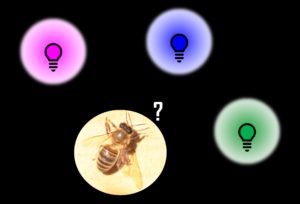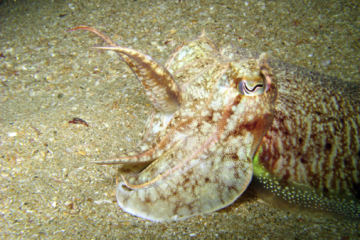
Morgane NOUVIAN
Former Fyssen 2016
Abstract
The ability to move towards or away from a light source, namely phototaxis, is essential for a number of species to find the right environmental niche and may have driven the appearance of simple visual systems. In this study we ask if the later evolution of more complex visual systems was accompanied by a sophistication of phototactic behaviour. The honey bee is an ideal model organism to tackle this question, as it has an elaborate visual system, demonstrates exquisite abilities for visual learning and performs phototaxis. Our data suggest that in this insect, phototaxis has wavelength specific properties and is a highly dynamical response including multiple decision steps. In addition, we show that previous experience with a light (through exposure or classical aversive conditioning) modulates the phototactic response. This plasticity is dependent on the wavelength used, with blue being more labile than green or ultraviolet.  Wavelength, intensity and past experience are integrated into an overall valence for each light that determines phototactic behaviour in honey bees. Thus, our results support the idea that complex visual systems allow sophisticated phototaxis. Future studies could take advantage of these findings to better understand the neuronal circuits underlying this processing of the visual information.
Wavelength, intensity and past experience are integrated into an overall valence for each light that determines phototactic behaviour in honey bees. Thus, our results support the idea that complex visual systems allow sophisticated phototaxis. Future studies could take advantage of these findings to better understand the neuronal circuits underlying this processing of the visual information.
« Mon travail se situe à l’interface entre éthologie et neurobiologie. Plus précisément, je cherche à comprendre comment les abeilles évaluent différentes informations pour prendre des décisions. J’ai bénéficié d’une bourse  Fyssen de Novembre 2016 à Octobre 2018, pour joindre l’université de Konstanz (Allemagne). Durant cette période, j’ai aidé au développement d’un nouvel appareil qui permet d’entrainer des abeilles sur des taches d’apprentissage aversif, en utilisant des stimuli visuels ou olfactif (https://www.frontiersin.org/articles/10.3389/fphys.2019.00678/full). Grace à cet appareil, nous avons pu explorer en détails comment les abeilles se comportent lors de décisions a priori simples : choisir entre lumière et obscurité, ou entre plusieurs lumières colorées. C’est ce qui fait l’objet de l’étude présentée ici.
Fyssen de Novembre 2016 à Octobre 2018, pour joindre l’université de Konstanz (Allemagne). Durant cette période, j’ai aidé au développement d’un nouvel appareil qui permet d’entrainer des abeilles sur des taches d’apprentissage aversif, en utilisant des stimuli visuels ou olfactif (https://www.frontiersin.org/articles/10.3389/fphys.2019.00678/full). Grace à cet appareil, nous avons pu explorer en détails comment les abeilles se comportent lors de décisions a priori simples : choisir entre lumière et obscurité, ou entre plusieurs lumières colorées. C’est ce qui fait l’objet de l’étude présentée ici.
A la suite de ce poste j’ai obtenu des financements pour rester à Konstanz (Zukunftskolleg Research fellowship, équivalent à un poste de Junior group leader). Mon projet actuel se concentre sur un autre type de décision, celle de participer ou non à la défense de la ruche. La défense étant un effort collectif, elle nécessite que les abeilles prennent en compte des informations non seulement sur le prédateur, mais aussi sur le comportement de leurs consoeurs. »
Social Neuroethology Group


